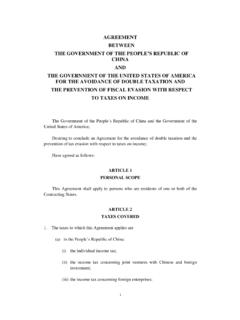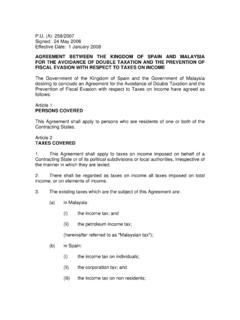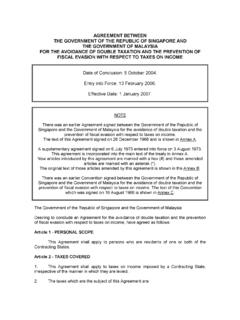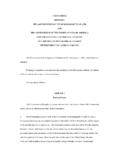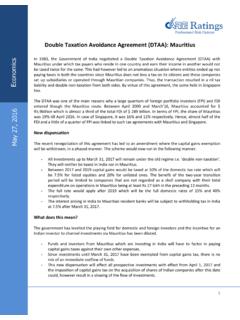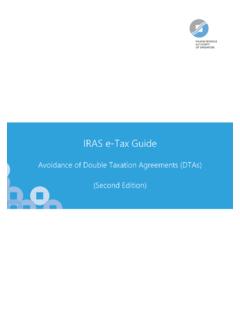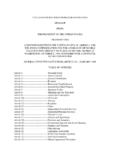Transcription of Convention Signed at Oslo December 3, 1971; …
1 UNITED STATES-NORWAYINCOME AND PROPERTY TAX CONVENTIONC onvention Signed at Oslo December 3, 1971; Ratification Advised by the Senate of the United States of America August 11, 1972;Ratified by the President of the United States of America August 28, 1972;Ratified by Norway May 5, 1972;Ratifications Exchanged at Washington September29, 1972;Proclaimed by the President of the United States of America October 31, 1972;Entered into Force November 29, EFFECTIVE DATE UNDER ARTICLE 31: 1 JANUARY 1971 TABLE OF ARTICLESCHAPTER 1 SCOPE OF CONVENTIONA rticle 1---------------------------------Taxes CoveredCHAPTER II DEFINITIONSA rticle 2---------------------------------Genera l DefinitionsArticle 3---------------------------------Fiscal ResidenceArticle 4---------------------------------Perman ent EstablishmentCHAPTER III taxation OF INCOMEA rticle 5---------------------------------Busine ss ProfitsArticle 6---------------------------------Shippi ng and Air TransportArticle 7---------------------------------Relate d PersonsArticle 8---------------------------------Divide ndsArticle 9---------------------------------Intere stArticle 10--------------------------------Royalt iesArticle 11--------------------------------Income from Real
2 PropertyArticle 12--------------------------------Capita l GainsArticle 13--------------------------------Indepe ndent Personal ServicesArticle 14--------------------------------Depend ent Personal ServicesArticle 15--------------------------------Teache rsArticle 16--------------------------------Studen ts and TraineesArticle 17--------------------------------Govern mental FunctionsArticle 18--------------------------------Privat e Pensions and AnnuitiesArticle 19--------------------------------Social Security PaymentsArticle 20--------------------------------Invest ment or Holding CompaniesCHAPTER IV taxation OF CAPITALA rticle 21--------------------------------Capita l TaxesCHAPTER V GENERAL RULESA rticle 22---------------------------------Gener al Rules of TaxationArticle 23---------------------------------Relie f from double TaxationArticle 24---------------------------------Sourc e of IncomeCHAPTER VI SPECIAL PROVISIONSA rticle 25---------------------------------Nondi scriminationArticle 26---------------------------------Diplo matic and Consular OfficersArticle 27---------------------------------Mutua l Agreement ProcedureArticle 28---------------------------------Excha nge of InformationArticle 29---------------------------------Assis tance in CollectionArticle 30---------------------------------Exten sion to TerritoriesCHAPTER VII FINAL PROVISIONSA rticle 31---------------------------------Entry into ForceArticle 32---------------------------------Termi nationLetter of Submittal----------------------of
3 13 January, 1972 Letter of Transmittal--------------------of 3 February, 1972 Notes of Exchange----------------------of 3 December , 1971 Protocol-------------------------------- ---of 19 September, 1980 Letter of Submittal (Protocol)---------of 13 November, 1980 Letter of Transmittal (Protocol)-------of 2 December , 1980 The Saving Clause --------------------Paragraph 3 of Article 22 MESSAGEFROMTHE PRESIDENT OF THE UNITED STATESTRANSMITTINGTHE Convention BETWEEN THE UNITED STATES OF AMERICA AND THEKINGDOM OF NORWAY FOR THE avoidance OF double taxation AND THEPREVENTION OF FISCAL EVASION WITH RESPECT TO TAXES ON INCOME ANDPROPERTY, Signed AT OSLO ON December 3, 1971 LETTER OF SUBMITTALDEPARTMENT OF STATE,Washington, January 13, PRESIDENT,The White House.
4 THE PRESIDENT: I have the honor to submit to you, with a view to its transmission to theSenate for advice and consent to ratification, a Convention between the United States of Americaand the Kingdom of Norway for the avoidance of double taxation and the prevention of fiscalevasion with respect to taxes on income and property, Signed at Oslo on December 3, 1971. This Convention , upon entry into force, would terminate and replace the Convention of June13, 1949, for the avoidance of double taxation and the prevention of fiscal evasion with respectto taxes on income, as modified and supplemented by a supplementary Convention of July 10,1958 (2 UST 2323; 10 UST 1924; Treaties and Other International Acts Series 2357 and 4360). On the occasion of the signing of the new Convention , the American Ambassador to Norwayand the Norwegian Minister for Foreign Affairs also Signed an exchange of notes relating tounderstandings in regard to certain provisions of the Convention , as explained more fullyhereinafter.
5 The texts of the notes are also submitted herewith with a view to their transmission,for the information of the Senate, along with the Convention . The new Convention takes into account important changes in the tax laws of the twocountries and developments reflected in recent tax treaties concluded by them with othercountries. It also reflects, as far as policy and technical considerations permit, the guidelinesestablished in the model draft Convention published in 1963 by the Organization for EconomicCooperation and Development. The substance of the new Convention is similar to that of income-tax conventions recentlyconcluded by the United States with France, Belgium, and Japan. The Convention retains thereciprocal exemptions from taxation of royalty and interest remittances and the maximumwithholding rate of 15 percent on portfolio dividends as provided in the 1949 Convention asmodified.
6 However, the maximum rate applicable to direct investment dividends is raised from 5to 10 percent in view of the adoption by Norway of a split rate corporate tax which provides for percent tax on distributed profits compared with percent on retained profits. UnitedStates tax treaties concluded with certain other countries which also have lower rates ondistributed profits provide a withholding tax of 15 percent. Norway, however, agreed to a 10percent withholding rate with respect to such profits. Under Norwegian law, Norwegian branchesof foreign corporations are taxed at the higher rate of tax applicable to retained profits. In thenew Convention , Norway has agreed to limit that tax as it applies to branches of United Statescorporations to the tax which would be imposed if the branch were a separate corporationdistributing the same proportion of its profits as the home office.
7 The new Convention , interpreted and applied in accordance with the understandings in theexchange of notes, also stabilizes the tax treatment of international transportation involving theuse of containers, the leasing of vehicles, and the use of partnerships and other forms of businessorganizations other than corporations. The exchange of notes makes it clear that the exemptionfor international shipping and aircraft income covers income from containers used ininternational traffic and income from the leasing of a ship or aircraft by a person engaged ininternational traffic. The exchange of notes states that, in the case of income derived by a partnerwho is a resident of one of the countries from an interest in a partnership which derives itsincome from the operation of ships or aircraft in international traffic and which is carried on withone or more partners resident in the other country, such income shall be taxable only in thecountry in which he is a resident.
8 Capital invested in such a partnership by partners resident inthe United States would be exempt from any Norwegian taxes on capital. The application ofArticle 6 in regard to the treatment of income earned by Scandinavian Airlines System, Inc. (aNew York corporation) from the operation of aircraft in international traffic is clarified inrelation to Scandinavian Airlines System, a consortium. Such income is to be treated as theincome of the consortium. The Convention contains a preamble and 32 articles. Chapter I (Article 1) indicates the scope of the Convention , specifying the taxes that arecovered. Chapter II (Articles 2-4) contains definitions of various terms found in the Convention . Chapter III (Articles 5-20) deals with the tax treatment of specific items of income, includingbusiness profits, shipping and air transport profits, income of related persons, dividends, interest,royalties, income from real property, capital gains, independent and dependent personal serviceincome, income from teaching or research, remittances of various kinds to students and trainees,remuneration for performance of governmental functions, private pensions and annuities, socialsecurity payments and income of investment or holding companies.
9 Chapter IV (Article 21) relates to capital taxes. Chapter V (Articles 22-24) contains general rules concerning taxation , relief from doubletaxation, and source of income. Chapter VI (Articles 25-30) contains special provisions regarding nondiscrimination,diplomatic and consular officers, mutual agreement procedure, exchange of information,assistance in collection, and extension to territories. Chapter VII (Articles 31 and 32) contains the final provisions regarding entry into force andprocedure for termination. The Convention would remain in effect for a minimum period of five years and indefinitelythereafter subject to the right of either party to terminate it by giving a six-month notice for thatpurpose. The Department of the Treasury, with the cooperation of the Department of State, wasprimarily responsible for the negotiation of the Convention submitted herewith.
10 It has theapproval of both Departments. Respectfully submitted,WILLIAM P. ROGERS.(Enclosures: 1. Tax Convention of December 3, 1971. 2. Exchange of notes.)LETTER OF TRANSMITTALTHE WHITE HOUSE, February 3, the Senate of the United States: With a view to receiving the advice and consent of the Senate to ratification, I transmitherewith the Convention between the United States of America and the Kingdom of Norway forthe avoidance of double taxation and the prevention of fiscal evasion with respect to taxes onincome and property, Signed at Oslo on December 3, 1971. For the information of the Senate, I transmit also the report of the Secretary of State withrespect to the Convention and copies of two notes Signed and exchanged on the same date as theconvention and relating to understandings concerning certain provisions of the Convention , asexplained in the Secretary's report.










